Current as of: April 20, 2024 - 02:18
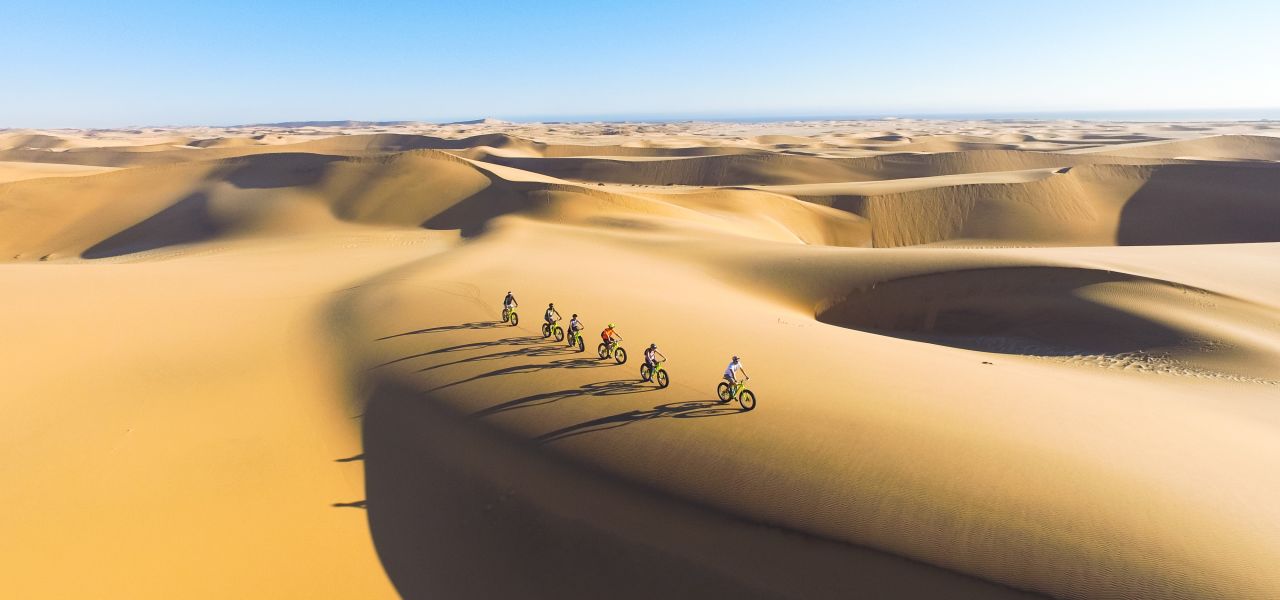
Cycle Namibia Trip Notes
- Ways to Travel: Guided Group, Private Group Adventures
- Destination: Namibia
- Programmes: Cycling
-
Activity Level:
3 out of 7 - Moderate
- 14 Days: Flight Inclusive
- 12 Days: Land Only
- Ages: 16+
- Trip Code: MZN
- Carbon Footprint: 12kg CO2e
Trip Overview
Enjoy an off-road bike adventure through stunning desert and over dunes
Namibia is a vast country with wide-open spaces and endless skies. Dunes gradually turn into granite hills, while rocky outcrops give way to vast plains where elephants, giraffes and lions roam. Travelling through the wilderness by bike is undoubtedly one of the best ways to experience the varied landscape of this desert nation and there is also the unique experience of cycling over dunes on a modified fat bike.
Discover the highlights and hidden secrets of the country on two wheels, watch the sun rise over some of the tallest dunes in the world and experience game drives in one of the best game reserves in southern Africa, Etosha National Park.
At a Glance
- Eight days of cycling (including a morning fat biking) with full vehicle support
- 90 percent off road/gravel roads, 10 percent paved roads
- Some gentle hills and mostly along quiet roads
- Group normally 4 to 12. Minimum age: 16
- Seven nights of full-service camping, four nights in hotels/lodges
- E-bikes available for an additional cost
Highlights
- Cycle through the wilderness – vast plains, rocky outcrops and endless skies
- Enjoy safari drives in Etosha National Park
- Explore dunes on a modified fat bike
- See a red table mountain in Waterberg National Park
- Discover some of the highest dunes in the world
Is This Trip for You?
This trip is graded Activity Level 3 (Moderate). For more on our trip gradings, visit our Activity Level Guidelines page.
- Average daily distance: 24mi (39km)
- Number of cycling days: Eight (including a morning fat biking)
- Vehicle support: Fully supported with the exception of the fat biking excursion

Route: The cycling is approximately 90 percent on gravel/dirt roads or off road and 10 percent on paved roads. There is a mix of terrain, including some rolling rides, flat, downhill and uphill sections. The support vehicle is available, especially for the more challenging sections. Most of the cycling on roads is with little traffic, though there may be some busier sections.
The fat biking on dunes is with a specialist guide and on modified bikes. You receive a tutorial before setting off but no experience is necessary. The terrain is rolling and you have the opportunity to cycle some steep gradients down the dunes. However, there is always the option of cycling down a gentler slope.
Safety: Helmets must be worn by all cyclists in Namibia.
Itinerary: On all days, we may do less or more cycling than stated in the Trip Notes. This depends on the ability and preference of the group plus the local conditions at the time. We also have many early starts.
Weather: It can get hot in Namibia and shade is not common on most of the rides.
Important flight information: If you’re booking your own flights, you should not book flights leaving before 3pm on the departure day.
Group
The trip is led by an experienced cycling guide and accompanied by a driver and camp assistant. The group is typically between four and 12 cyclists.
Adult min age: 16
Min group size: 4
Max group size: 12
Itinerary
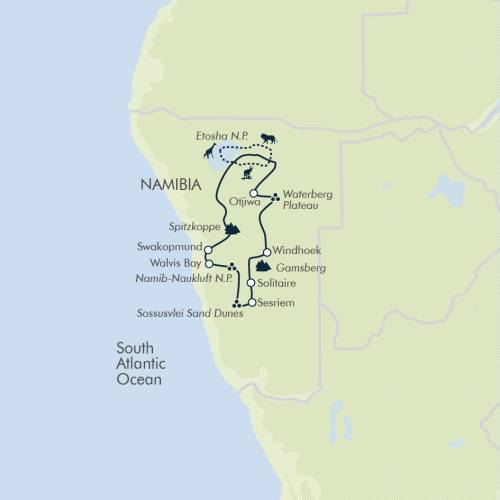
Land Only
- Start City: Windhoek
- End City: Windhoek
Land Only Itinerary
Depart London; Fly to Windhoek via Johannesburg.
Depending on your arrival time at the hotel, there is time today to go into Windhoek and explore the city at your own pace or you can relax at the lodge.
Accommodation: Arebbusch Lodge (or similar)
Depending on your arrival time at the hotel; there is time today to go into Windhoek and explore the city at your own pace, or you can relax at the lodge.
Accommodation: Arrebusch Lodge (or similar)
Leaving Windhoek, we start with a short transfer towards the Khomas Hochland and the top of the Kupferberg Pass. From here, we get our first taste of cycling through the amazing landscapes of Namibia as we descend along winding roads past private farms and local wildlife, getting used to the terrain for about 28mi (45km) while stopping regularly for snacks and pictures. After lunch, we transfer up Gamsberg Pass and pass the third-highest mountain in Namibia, from where we have views stretching 62mi (100km). On the way down the pass and past the dry riverbeds, we should hopefully see baboon troops and Hartmann’s mountain zebras before reaching our camp for the evening.
Accommodation: Rooisand Desert Ranch (or similar)
Leaving camp on our bikes, we continue along gravel roads on rolling hills. We cycle all the way to the meeting of two roads, where we start to see red dunes, and then transfer the rest of the way to Solitaire via the Guab Pass. We aim to get to Solitaire for lunch and hopefully have the opportunity to try the local apple crumble, which has been called the best in the Southern Hemisphere. After lunch, we transfer to Sesriem and then there is an optional bike ride to Elim Dune in the late afternoon (5mi/8km).
Accommodation: Sesriem Camp (or similar)
Waking early, we drive 25mi (40km) to some of the highest dunes in the world before climbing Dune 45 as the first sunrays peak over the horizon and hit the red-ochre sand. After descending, we have breakfast with a view before taking to our bikes for a ride back to Sesriem along a paved road cutting through the towering dunes. Depending on the weather, we may be able to do a 15.5mi (25km) ride to Sossusvlei and have a quick walk. After lunch at camp, we transfer to Solitaire, arriving in time for an optional stroll or gentle ride before sunset. In the afternoon, we can visit the Namib Carnivore Conservation Centre to see cheetahs (depending on time, we may go tomorrow morning).
Accommodation: Solitaire Camp (or similar)
After a short transfer, we continue on our journey north, cycling towards the Tropic of Capricorn. If conditions allow, we have the option of cycling over the Kuiseb Pass or a different route towards the coast. With luck, we should see ostriches, springbok, gemsbok and mountain zebras. Once again, we end our ride in the shadow of Guab Pass before transferring to Walvis Bay, which is known for its flamingos. From here, we continue to Swakopmund, driving with the ocean on the right and the dunes on the left.
Accommodation: Prost Hotel (or similar)
This morning, we are introduced to our modified fat bikes and cycle into the vast expanse of dunes surrounding Swakopmund. Fat bikes have very wide tyres that make it possible to cycle over sand and explore areas that regular mountain bikes are unable to reach. Our ride takes approximately 3hr 30min and includes the nearby Moon Valley landscape plus a coastline section if the tide is in our favour. On our return to Swakopmund, we have a free afternoon to enjoy one of the many optional activities available nearby, such as sandboarding or quad biking. If you feel like relaxing, this Germanic town is renowned for its cake and coffee shops.
Accommodation: Prost Hotel (or similar)
We leave Swakopmund this morning for Spitzkoppe, the Matterhorn of Namibia, an impressive granite peak rising from the gravel plains. We explore the area by bike and on foot in the late afternoon. When there have been good rains, it may be possible to find rock pools where we can take a refreshing dip. Later in the afternoon, we can go on an optional bike ride or short hike in the area.
Accommodation: Spitzkoppe Camp (or similar)
After a relaxing start to the morning, we transfer to Etosha National Park, one of the best game-viewing parks in southern Africa. We go on a late afternoon game drive in search of various wildlife, including elephants, rhinos and lions. In camp, we can sit by the watering hole, which is floodlit at night, and enjoy the living theatre that unfolds as animals come to drink the water.
Accommodation: Okaukuejo Camp (or similar)
Today is dedicated to safari. We go on morning and afternoon game drives and have the opportunity to relax in camp during the heat of the day when the wildlife hides from the Namibian sun.
Accommodation: Okaukuejo Camp (or similar)
We leave Etosha National Park and transfer approximately 75mi (120km) to Otjiwa, the oldest safari lodge in Namibia. After lunch, we go on an afternoon ride along the jeep tracks and hopefully see some of the local wildlife. For our last night of camping, we enjoy a delicious braai (barbecue) under the African night sky.
Accommodation: Otjiwa Safari Camp (or similar)
This morning, we cycle from camp along the jeep tracks of Otjiwa Lodge for about three hours while looking for wildlife. We then transfer to our accommodation at the impressive red table mountain formation of the Waterberg Plateau, where we can cool off in the pool and enjoy our last night of the trip in a comfortable room. This afternoon, we can also go for a walk on the Waterberg Plateau.
Accommodation: Waterberg Lodge (or similar)
A 3hr 30min drive brings us back to Windhoek, where our adventure ends. Bid farewell to new-found friends and begin your return journey home. If you’d like the adventure to continue, speak to our sales representative about extending your stay.
Please note: The group transfer back to Windhoek is scheduled to align with a chosen flight to London, UK; therefore, you should not book flights leaving before then. Please contact your sales representative for the timings of this flight.
Arrive London
Ascents, descents and distances
All ascents, descents and distances listed above have been measured by our local partners or tour leaders, in many cases with satellite-based mapping software. Please note, different GPS measuring devices can give differing results, particularly on winding paths or in mountainous terrain. Measurements stated throughout these trips notes are given to help you understand the types of terrain and distances you will encounter. Timings stated will vary depending on the pace of your group.
Accommodation
Hotels and camping
On this cycling adventure in Namibia, we spend seven nights camping and four nights in hotels – bring your swimwear, most of the places we stay have pools. Below is a rundown of the hotels we typically use and some advice on camping.
Hotels
Windhoek: Arebbusch Lodge (night 1)

Our guesthouse is only a 10-minute drive from the city centre yet is spacious with two swimming pools and one of the best pizzerias in the capital. It also has a beautiful garden enlivened with indigenous trees.
Swakopmund: Prost Hotel (nights 5-6)
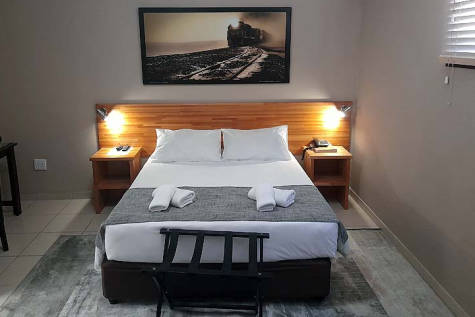
After a few camping nights, we hop back into a clean, comfy room with a stay at the Prost Hotel. When we’re not out riding dunes on fat bikes, this 28-room hotel is well-placed for visiting Swakopmund and its pubs, restaurants, and cake and coffee shops.
Waterberg: Waterberg Resort (night 11)
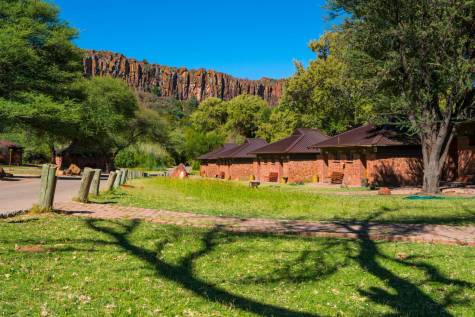
We spend our final night of the trip in the comforts the Waterberg Resort, where we can sink into a comfy bed. Find further relaxation in the swimming pool and enjoy our last night together in the restaurant and bar.
Camping
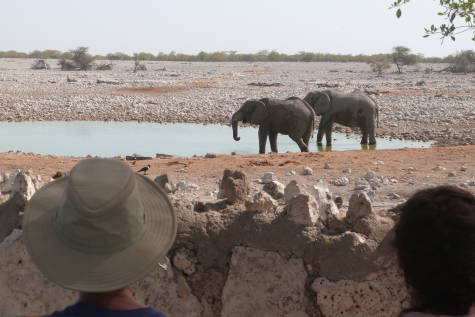
Namibia is a fantastic destination for camping. The landscapes are grand and unpopulated, wildlife is widespread plus the campsites are clean and well maintained. All communal camping gear is provided, including spacious two-person dome tents, thick foam mattresses and folding stools, although you need to take your own sleeping bag.
In Etosha, we stay within the national park itself – a huge plus for any animal lover and a highlight of the trip for many. The resorts we use (nights 8-9) are either Okaukuejo, Halali or Namutoni. Each location has a restaurant, swimming pool and bar but the highlights are the flood-lit waterholes where wildlife regularly stops to drink and bathe.
Worth knowing
- Due to the limited amount of accommodation within Etosha National Park, it may be necessary to sleep outside the park on some or all of the nights we are there.
Single supplement from £ 255
Food & Drink
All breakfasts, two lunches, five dinners are included.
When staying at campsites, our guides cook for you. These will be hearty meals cooked over an open fire; expect braai (barbecue), potjie (stew) and stir fries for dinner. Breakfasts are continental and usually consist of cereals, coffee, yoghurt, muesli, fresh fruit or the occasional fried breakfast. For lunch, expect a good selection of sandwich ingredients such as cheese and cold meats plus pasta and salads. Our support vehicle carries a good selection of snacks and drinks, which are available to access every 9mi (15km) or so when the group stops.
Vegetarians can be catered for but please inform us before departure of any special dietary requests.
Transport
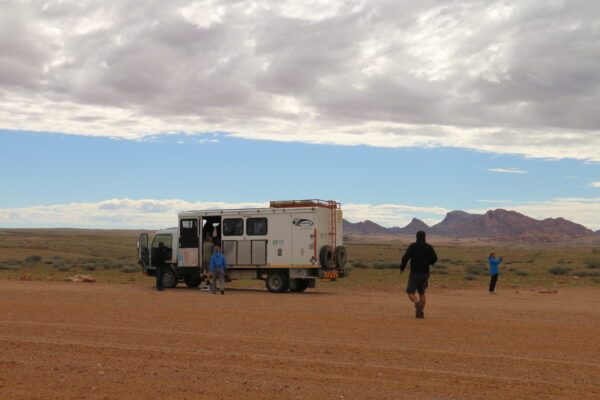
The support vehicle normally used for trip is a specially modified safari truck with ten to twelve seats for clients. Seating is forward facing and the windows are large and easy to open. Smaller groups may be in a Hilux/Land Cruiser. People are expected to move around to permit everyone a chance to have a window seat. There is plenty of legroom and packing space as well as a reference library and icebox. Please note, it is not safe to stand when the vehicle is moving, please remain seated until the vehicle stops, even on game drives. The bikes are stored in or on top of a trailer towed by the vehicle.
Weather & Seasonality
June, July and August, while clear and warm during the day, can be cold and even freezing at night. Between September and May, it is considerably warmer with the time between October and April being the hottest, when it often reaches 30C (86F). However, it is always a dry heat and the temperature does drop at night. The wet season is between November and February (this can vary a month either side), but this is not a bad time to go as the desert blooms after rainfall and it never rains for very long.
Joining Instructions
Key information
Start hotel: Arebbusch Lodge, Cnr of Golf & Auas Rd, Olympia, Windhoek
Phone: +264 61 252 255
Recommended arrival time: You can arrive at any time today. There will be a welcome briefing in the evening, but if you miss it the leader will update you separately
Airport: Windhoek Airport (WDH)
Getting to the start hotel
The start hotel is approximately 45 minutes’ drive from the airport. Exodus provides free arrival transfers to the start hotel from the airport for all customers. If you would like further information on joining this trip, please speak to your sales representative.
Catching your return flight
The last night of the trip is spent in the Waterberg Plateau Park and the tour finishes in Windhoek. The group transfer back to Windhoek is scheduled to align with a chosen flight to London, UK; therefore, you should not book flights leaving before then. Please contact your sales representative for the timings of this flight. Free airport departure transfers are only available for return flights departing after the chosen flight route to London – from our Windhoek hotel (if you have booked post tour accommodation) to the airport.
Please note, unless specified otherwise, the transfers will be to the start (or pre-tour) hotel and from the end (or post-tour) hotel and will be on the date on which the tour starts/ends; transfers to other hotels in the same city and/or on different dates may attract an extra charge. Transfers should be booked with your sales representative at least two weeks before the tour starts.
Full joining instructions including local emergency numbers will be sent to you as part of our Final Joining Instructions. If you do not receive these at least a week before departure, or require them earlier please contact our office or your travel agent.
Full joining instructions including local emergency numbers will be sent to you as part of our Final Joining Instructions. If you do not receive these at least a week before departure, or require them earlier please contact our office or your travel agent.
Location start: Windhoek
Location end: Windhoek
Transfer Details
Exodus offers FREE airport arrival transfers on any flight for this trip, for both Land Only and Flight Inclusive clients, so no matter which flight you choose to arrive on you will be met and transferred to your hotel. All those taking advantage of the free airport transfers must provide full flight details for both arrival and departure in advance; unless specified otherwise, the transfer will be to the Exodus start (or pre-tour) hotel; transfers to other hotels in the same city may attract an extra charge; transfers may be shared with other Exodus customers on the same flight, or on a flight with similar arrival times.
The last night of the trip will be spent in the Waterberg Plateau Park and the tour finishes in Windhoek. If your return flight home departs before the group flight you may have to get a private transfer from Waterberg to Windhoek. Please ask a member of our sales team for more details. FREE airport departure transfers are only available for return flights departing after the group flight – from our Windhoek hotel to the airport.
What To Take
Essential Equipment
You should bring the following essential items:
- Travel pillow
- Sleeping bag (three/four-season if travelling in July/August – otherwise two-season)
- Normal daily clothes
- Lightweight waterproof jacket
- Small backpack (for camera and snacks)
- Torch (flashlight) for camping
- Towel
Water Included
Plastic bottles are a big issue in many countries where recycling isn’t yet widely available; they often end up in landfill sites or get burned, both processes are harmful to the environment and we would like to reduce our impact here. On your trip the tap water is safe to drink throughout most of Namibia and the vehicle has a water tank. This means that safe drinking water will be available throughout and all you need to do is bring a bottle to re‐fill along the way. During the drier months, tap water may not taste as nice. If you prefer the taste of bottled water, it is possible to purchase and re-fill from 5l bottles throughout the itinerary.
Plastic waste reduction: Please bring your own reusable water bottle on this trip. Tap water is safe to drink throughout most of Namibia and the vehicle has a water tank that we can use while on the road. If you prefer the taste of bottled water, it is possible to purchase and refill from 5l bottles throughout the itinerary.
If while packing you find a spare bit of space in your bag, please be sure to check out our partner Pack for a Purpose to identify items that are needed locally by schools and medical clinics. Your tour leader can assist with donating the items.
Optional Equipment
The temperature in July and August can get really cold, especially at night. We strongly recommend you bring plenty of warm clothing if you’re travelling at these times of the year.
Equipment Hire
Included standard bike
The standard bikes used for this trip are Silverback models (Stride Comps, Stride Sports and Spectra Sports) plus GT Aggressor Experts.
We will take your height at the time of booking to reserve equipment. If you have a preferred bike size, please request when booking.
E-bike upgrade
Electric bikes are available on this trip. Speak to your sales representative for more information.
Bringing your own bike
If you’d prefer to bring your own bike, please advise us at the time of booking and you will receive a discount on the price of the trip. However, you will be responsible for any extra baggage charges; assembling and disassembling your bike; and bringing along spare parts and any tools specific to it. You should also ensure you have adequate insurance to cover loss, damage or theft.
Accessories and clothing
Bringing equipment from home
You’re welcome to bring your own equipment, such as SPD pedals or clipless pedals, your own saddle (excluding the seat post), or gel saddle cover for the hire bikes. Your leader will help you fit these when bikes are distributed.
Helmets
Helmets are mandatory for everyone on a guided Exodus cycling trip. You must bring your own as, following best safety practice, they are not available for hire.
Cycling clothing
For this cycling trip we recommend:
- Padded cycling shorts: For destinations with more modest cultures, we also recommend loose ‘over-shorts’ for riding or rest stops
- Eyewear: Either sunglasses or eye protection with clear lenses to protect the eyes while riding
- Cycling gloves: Especially for riding off-road or on rugged surfaces
- Cycling shoes: Cycling is more efficient with stiff-soled shoes. We don’t recommend open-toed shoes or sandals
- Small close-fitting backpack or bum bag (fanny pack): To keep spare clothing or essential items to hand during the ride
- Several cycling jerseys
- Warm base layers
Practical Information
Passport
Remember to check the expiration date of your passport if travelling internationally. Many countries require your passport to be valid for at least six months after the date of your scheduled return.
Visa
Namibia
Travellers from the UK, US and some EU states normally do not need a visa to enter Namibia. Please note, visa requirements often change and it is your responsibility to obtain any required visas for this trip. Therefore, we recommend that you check with the nearest embassy or consulate of your chosen destination(s), including any countries you may be transiting or transferring through.
Some local governments provide guidance on what visas their citizens need. To help, we’ve gathered a selection of useful links below.
• Australia: www.smartraveller.gov.au/destinations/africa/namibia
• Canada: www.travel.gc.ca/destinations/namibia
• United Kingdom: www.gov.uk/foreign-travel-advice/namibia/entry-requirements
• USA: www.travel.state.gov/content/travel/en/international-travel/International-Travel-Country-Information-Pages/Namibia.html
If you are transiting through South Africa and are a non-UK passport holder you may require a transit visa. Please check before travelling. Please note that if flying via South Africa you will probably have to pass immigration there.
Passports: To enter Namibia, your passport must have an ‘expiry date’ at least 6 months after the date you arrive. It must also have at least one blank page. If you’re travelling to South Africa, you will need an additional 2 blank pages.
Travelling with children: In addition to valid passports, parents travelling with children (under 18) should at all times carry the original or certified copy of the unabridged birth certificate (listing the child’s and both parents’ details). Adults travelling with children where they are not the biological or legal guardians of those children, should be in possession of an affidavit statement from the child’s parents giving consent for their travel. If a child is travelling with only one parent, the other parent should give consent for travel in the form of an affidavit.
Vaccinations and Health
Namibia
There are no required vaccinations. However, recommended vaccinations include hepatitis A, hepatitis B, tetanus, typhoid, cholera, rabies and tuberculosis. Malaria prophylaxis is essential, seek advice from your doctor about which malaria tablets to take. You will also need a yellow fever vaccination certificate if you’re arriving from a country with risk of yellow fever transmission or transiting for more than 12 hours through a country with risk of yellow fever transmission. Please confirm all requirements and recommendations with your doctor or travel clinic.
The Travel Health Pro website recommends to have a rabies vaccination on this trip, as cycling is considered a higher risk activity.
Local Time
Namibia's time zone: Africa/Windhoek (UTC +02:00)
Electricity
Nearly all the campsites/lodges provide a power point where you can charge your camera batteries. The power point is normally in a communal area such as the kitchen or bar. Most of the vehicles are fitted with an inverter to allow you to charge your batteries while on the move (using European-style plugs), but space is limited so you should not rely on this being available. Namibia generally uses the same sockets as South Africa (large round pins) –adaptors may be hard to come by but are generally available at the airport before departure.

Money
Namibia's currency: Namibian dollar (NAD)
ATM Availability
Credit cards are widely accepted, and there are ATMs in the main towns and the airport, but you should not rely on this for all your money.
Extra Expenses & Spending Money
Budget an average of 370 Namibian dollars (US$20) a day for non-included meals and snacks.
Optional excursions (approximate costs, depending on group sizes)
There are several optional activities in Swakopmund, such as ocean fishing and quad biking but there’s plenty to occupy you if you don’t participate. These prices are subject to change:
- Quad biking: N$850 (US$58) for two hours or N$600 (US$40) for one hour
- Flight over Sossusvlei: N$5,300 (US$360)
- Desert night drive (Day 3): 200 dollars (US$13.50)
- Township tour: N$750 (US$52)
Tipping
Our local staff are paid well and fairly for their work. Tipping is entirely optional but we recommend approximately 25-45 Namibian dollars (US$1.70-US$3) per person per day. For other staff such as porters, we recommend that you budget for a further USD5-8
People, Places & Planet
We work hard to create trips that have a positive impact on the people and places we visit and look after the planet we explore. Learn more about our sustainable travel ethos and practice here and find out about the work of the Exodus Travels Foundation here.
Some sustainable travel highlights of this trip include:
People
How this trip helps improve life for local communities.
- Local guides keep you well informed about local traditions and cultural-social sensitivities.
- This trip brings income and opportunity to the destination community through the inclusion of locally owned hotels, restaurants, and other enterprises, and by championing locally produced food wherever possible.
- Read more about our other initiatives here.
Places
How this trip helps protect and conserve local landscapes and nature.
- By travelling in a small group, we ‘tread lightly’ to minimise our impact on local resources and the environment.
- We work with our partners on the ground to proactively reduce waste; this includes eliminating all single-use plastic water bottles by providing refills for reusable bottles.
- The payment of entrance fees to natural reserves generates income which is used to upkeep and develop these important sites. We visit Etosha National Park.
- Our trips adhere to ABTA’s industry-leading animal welfare guidelines to ensure the best possible practices regarding working animals and wildlife viewing. Our animal welfare policy can be found here.
- We rewild 1,075sqft (100sqm) per passenger to compensate for all trip and flight emissions.
- Read about our commitment to nature protection and restoration here, including our rewilding commitment for every customer who travels with us.
Planet
How we seek to keep the carbon footprint of this trip low.
- Accommodation and restaurants in the itinerary use locally sourced food which has not been transported long distances.
- Cycling trips like this have very little detrimental impact on the environment and the locals, as it is a quiet, low-impact activity requiring comparatively few resources to support.
- Read about our climate action here, including our carbon reduction and compensation commitments.
Tips for sustainable travel on this trip
- Leave no trace: We do all we can to ensure we leave no rubbish in the wild and beautiful places we visit; we ask that you do the same. If there are no recycling facilities in-country, consider bringing recyclable materials home with you.
- Plastic waste reduction: Please bring a reusable water bottle on this trip, also consider avoiding single-use hotel toiletries, which generate a large amount of plastic waste.
Important Information
Optional activities and excursions
If you would like to join an optional activity or excursion outside those listed in the itinerary, your leader may be able to assist with selecting a provider. However, Exodus has not assessed the safety standards of activities or excursions that are not listed in the Trip Notes. All optional activities or excursions are undertaken at your own risk.
Water safety
This trip includes time by a lake, river or sea, where there may be opportunities to swim. You should always seek local advice before deciding whether to swim. Open-water or wild swim spots should be treated with extreme caution. Information on how to keep yourself safe while swimming is shown here.
Important Information
Your safe participation
When booking this trip, you should be confident in your ability to participate in all activities described in these Trip Notes. If you have any doubt about your suitability, please call the Exodus office and ask to speak to one of the experts on this itinerary.
Although our leaders are well trained to deal with different capabilities, if they have any concerns about someone’s ability to safely take part in an activity, or their impact on other people’s enjoyment, we authorise them to take necessary action which, in some circumstances, may involve asking someone to miss that activity.
By booking this trip you agree to our Booking Conditions which clearly state that our leaders have the authority to do this. In these rare instances we will ensure anyone sitting out is safely provided for and offered alternative options where possible. Refunds will not be provided for activities missed and customers may be liable for additional costs incurred.
How to Book
- Check availability: Go online to check availability, or contact us by phone or email.
- Secure your place: You can provisionally hold a place on this trip, usually for between three and seven days.
- Complete your booking and payment
When you’re ready to book, go to our website for online bookings, book over the phone or you can complete a booking form (available online or on request by calling us). We accept all major credit and debit cards, or you can pay be cheque.
After booking
You will receive your booking confirmation letter and invoice, which includes extra information and guidance about your travel arrangements.
Full joining instructions, including local emergency numbers and details of how to reach the start point, will be sent to you approximately two to three weeks prior to departure. If you do not receive these at least a week before departure, or require them earlier, please contact our office or your travel agent.
Trip Note validity
These Trip Notes are valid from the “Current as” date on page one. They will occasionally be updated after booking and before departure; if there are any updates that significantly impact the inclusions or itinerary, customers will be written to separately. They will also receive a link to the most up-to-date Trip Notes with their Final Joining Instructions before travelling.
The information in these Trip Notes is given in good faith. Where differences exist between the Trip Notes and our current brochure or website, the Trip Notes supersede the brochure and website. All holidays can be subject to unexpected changes; to enjoy them you should be prepared to be flexible where necessary. Occasionally, it may not be possible to follow the itinerary as planned. This may be for a variety of reasons – climatic, political, physical or other. In these circumstances we will make the best-possible alternative arrangements that maintain the integrity of the original itinerary.
Licensing
Exodus is fully licensed and bonded as a tour operator. We hold Air Traffic Organisers Licence (ATOL) number 2582, issued and bonded with the Civil Aviation Authority (CAA). We are also bonded to the International Air Transport Association (IATA) and we are members of the Federation of Tour Operators (FTO) and ABTA – The Travel Association. This means you can book your Exodus holiday with confidence, as all money paid to us for your trip is fully protected.